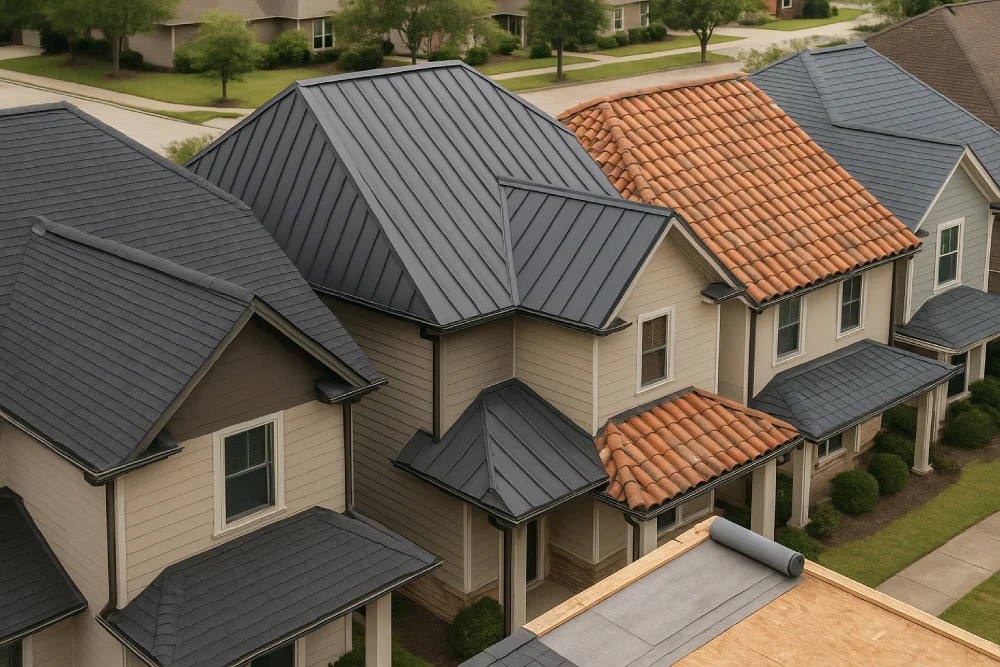
Choosing the right roofing system for a home is indispensable for long-term value. Homeowners should consider various materials, like asphalt shingles for affordability or slate for beauty and durability. Evaluating warranties helps guarantee quality, while understanding weather resistance guides appropriate choices for local climates. Installation costs vary significantly based on material and complexity. Upkeep needs are pivotal for lifespan expectations. Exploring these factors in detail will provide insightful perspectives into making an informed and assured choice for a home.
When it comes to roofing, selecting the right material can significantly impact a building's durability, aesthetic appeal, and efficiency. Homeowners often consider various types, including asphalt shingles, slate, clay tiles, synthetic options, and low-slope membranes. Asphalt shingles are popular due to their affordability and versatility, enhancing both aesthetics and curb appeal. Additionally, many homeowners in Texas prefer impact-resistant shingles to withstand severe weather conditions. Slate offers unmatched beauty and longevity but requires a strong structure, raising environmental impact considerations. Clay tiles shine in hot climates but can stress buildings, while synthetic materials provide durability with fewer natural benefits. Low-slope membranes like EPDM and PVC are effective for flat roofs, yet their environmental trade-offs must be assessed. Ultimately, the choice of roofing material influences not just appearance but also long-term sustainability. Additionally, solar tiles can effectively reduce energy bills to zero, making them an attractive option for energy-conscious homeowners.
How can homeowners guarantee they choose the best roofing system for their needs? Evaluating roofing system packages and warranties is vital for making an informed decision. Basic packages, like the Essentials Roofing Package, offer a 10-year warranty, ideal for short-term solutions. In contrast, mid-level options, such as the Peace of Mind Package, provide a 25-year warranty, enhancing durability for long-term homeowners. Premium packages often feature extended warranty coverage, reaching up to 50 years, while also incorporating high-quality materials for improved aesthetic considerations. These distinctions not only impact initial costs but can also influence long-term value and peace of mind. Homeowners should carefully consider the warranty details and material quality to confirm their investment aligns with their needs, as longer warranties often lead to higher ROI, particularly for those planning to sell their homes. Additionally, working with a company known for dependable project management can further ensure that the roofing installation process runs smoothly and efficiently.
Choosing the right roofing system extends beyond just warranties and initial costs; it requires an understanding of durability and weather resistance. A longevity assessment reveals that materials like slate tiles can last up to 200 years, while asphalt shingles offer a shorter lifespan of 15 to 30 years. Weather resistance varies, with slate tiles being nearly impervious to harsh conditions. The following table summarizes the durability and weather resistance of various roofing options:
| Roofing Type | Longevity (Years) | Weather Resistance |
| Slate Tile | 75 - 200 | Excellent |
| Clay Tile | 50 - 100 | Good |
| Standing Seam Metal | 30 - 70+ | Excellent |
| Asphalt Shingles | 15 - 30 | Moderate |
| Wood Shakes | 25+ | Fair |
The choice of roofing should also consider environmental sustainability, particularly with materials that have a longer lifespan. Slate tiles are not only resilient but also require regular inspections to ensure their integrity over the years. Additionally, using high-performing, environmentally responsible materials can enhance the overall quality and lifespan of your roofing system.
When choosing a roofing system, installation complexity and associated costs significantly influence the decision-making process. Various materials, including asphalt shingles and metal roofing, differ greatly in labor intensity, affecting overall expenses. Recognizing these factors empowers homeowners to make informed choices that align with their budget and project requirements.
Several factors contribute to the intricacy of roofing installation, significantly impacting both time and costs. Understanding these elements can help homeowners make informed decisions when selecting a roofing system. Key considerations include:
The competence of contractors and team composition also play pivotal roles in managing these intricacies, ensuring that projects are completed efficiently and to a high standard. Thus, careful planning and professional guidance are essential for successful roofing installations.
A thorough cost comparison is essential for homeowners considering a new roofing system, as it encompasses various factors that influence the overall investment. Material pricing considerations and labor cost factors play a significant role in determining total expenses. Below is a summary of estimated costs for different roofing types:
| Roofing Type | Cost per sq. ft. (Installed) |
| Asphalt shingles | $5 – $16 |
| Metal roofing | $7 – $40 |
| Tile roofing | $10 – $27 |
| Slate/stone | $8 – $35 |
Additionally, factors such as labor rates, disposal costs, and local regulations can escalate the total project cost. By understanding these aspects, homeowners can make informed decisions that align with their financial plans and roofing needs.
Choosing the right roofing system involves understanding both the maintenance requirements and lifespan expectations of various materials. Each roofing type presents unique seasonal maintenance needs and benefits. Homeowners should consider the following:
Implementing preventive maintenance strategies, like routine inspections and gutter cleaning, can significantly extend the life of a roof while reducing repair costs.
Selecting a roofing system requires a keen understanding of regional suitability and climate adaptation to ensure long-lasting performance. Different materials perform better in specific climates; for instance, TPO suits warm areas while EPDM is ideal for colder environments. Making climate-specific choices proves essential. Weather resistance requirements and regional installation considerations significantly impact the overall effectiveness of the roofing system.
Selecting the right roofing materials is crucial for homeowners, as it significantly impacts the longevity and efficiency of a home. Different climates require specific materials to optimize energy efficiency potentials and manage thermal mass properties effectively.
Understanding weather resistance requirements is essential for homeowners, as the right roofing system can safeguard a property against varying climatic challenges. In regions prone to harsh weather, materials must provide sturdy protection. Metal roofing, for example, is highly effective against severe winds, achieving ratings up to 140 mph, making it ideal for hurricane-prone areas. Additionally, TPO and modified bitumen systems excel in heavy rainfall, minimizing water infiltration and supporting ice dam prevention. Hail impact ratings also play a critical role; asphalt shingles, when impact-resistant, can withstand winds up to 130 mph. Selecting a roofing system that meets these weather resistance standards guarantees long-term durability and peace of mind, protecting homes from the elements effectively.
Choosing the right roofing system involves careful consideration of regional installation factors, as different climates and local building codes significantly influence the overall effectiveness and longevity of a roof.
Key aspects to consider include:
Engaging in code compliance verification and local authority consultation is essential. This guarantees that roofing systems not only meet safety standards but also adapt to the unique environmental challenges of the region, ultimately safeguarding the home for years to come.
How can homeowners guarantee they pick the best roofing system for their unique needs? First, they must consider their homeowner budget considerations alongside their aesthetic design preferences. Understanding architectural style is essential; for example, asphalt shingles suit most styles, while tile roofing is perfect for historic homes. The roof's color and texture should harmonize with the home's exterior. Additionally, materials must withstand local weather conditions, ensuring durability and longevity. Homeowners should evaluate the long-term costs, including maintenance and energy efficiency, as some materials offer savings on utility bills. Ultimately, choosing a roofing system involves balancing budget, style, and environmental factors, leading to a decision that enhances both the home's appearance and its value.
In conclusion, choosing the right roofing system for your home requires a thoughtful evaluation of several key factors, including the types of materials available, their durability, and how they perform in your specific climate. By carefully reviewing warranties and installation costs, you can arrive at a decision that not only adds value to your property but also ensures its longevity. It's important to consider maintenance requirements and expected lifespan, as these elements will help you select a roof that effectively protects your home while enhancing its overall appearance.
With the right choice, you can have confidence in a roof that will stand the test of time. At TriStar Built, a locally owned and insured construction company in North Texas, we prioritize quality craftsmanship and maintain strong relationships with our subcontractors. Our client-focused approach ensures that you receive clear communication and trustworthy service throughout your roofing project.
To choose the right roof color, one should consider roof color preference and the architectural style impact. Traditional homes may favor muted tones, while modern designs can wrap themselves in bold colors for enhanced visual appeal.
Determining if a new roof can be installed over an existing one requires a potential roof condition assessment and careful consideration of roofing material compatibility to guarantee structural integrity and long-term performance without concealed issues.
The environmental impacts of roofing materials vary significantly. Sustainability considerations include recyclability and energy efficiency, while effective choices promote environmental footprint reduction, contributing to longer lifespans, lower emissions, and less waste in landfills.
To improve energy efficiency, one should consider improving attic insulation and increasing roof ventilation. These enhancements work together, reducing heat buildup and minimizing cooling costs, ultimately leading to a more comfortable and cost-effective living environment.
Various financing options exist for roofing projects, including contractor payment plans and financing assistance. Home equity loans and HELOCs offer flexible borrowing, while specialized programs cater to multifarious financial needs, ensuring homeowners can manage costs effectively.

Whether you’re remodeling a home, expanding a business, or starting from the ground up, TriStar Built is here to guide you every step of the way. With a focus on craftsmanship, communication, and results that last, we make the construction process clear, smooth, and worth every investment.

LOCATION: 2126 James Street, Denton, TX 76205
PHONE: (940) 381-2222
© 2025 TRISTAR BUILT - ALL RIGHTS RESERVED | WEB DESIGN & SEO BY: Authority Solutions®